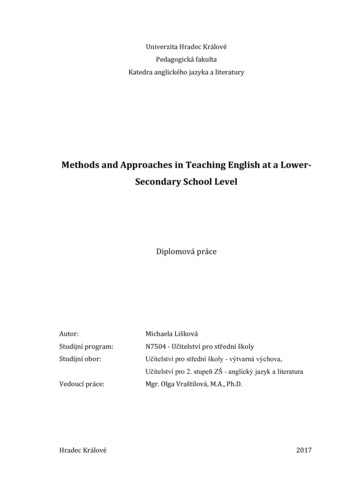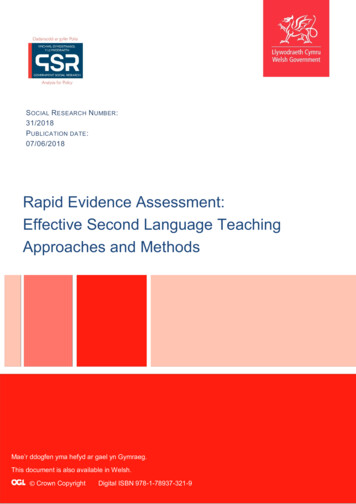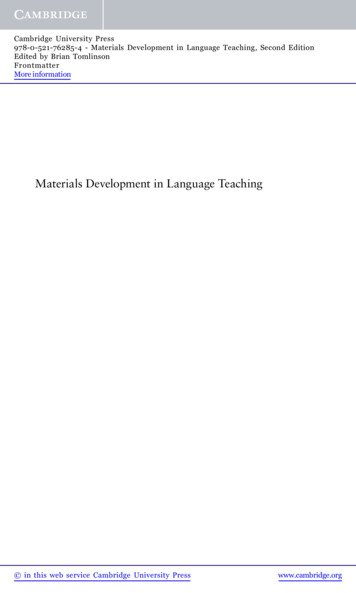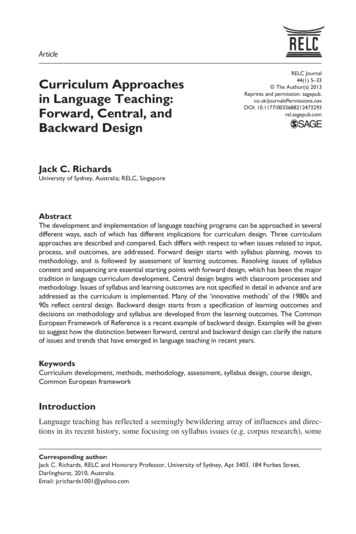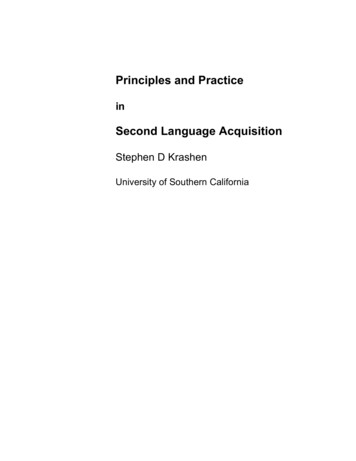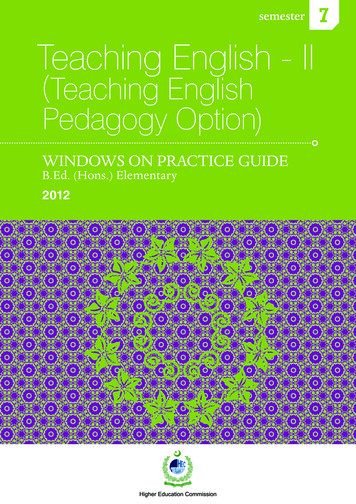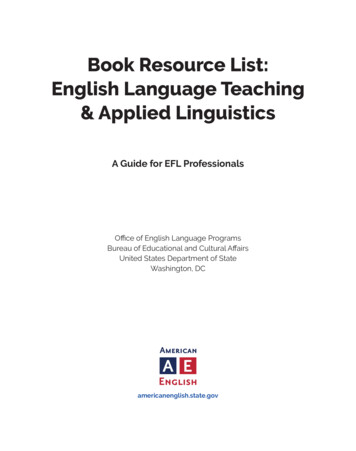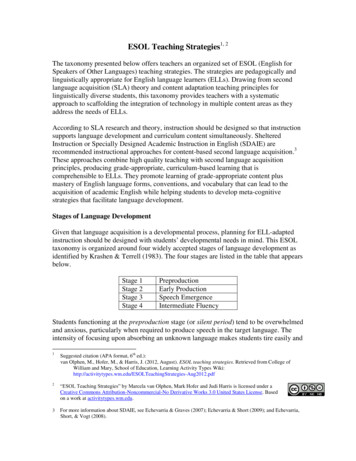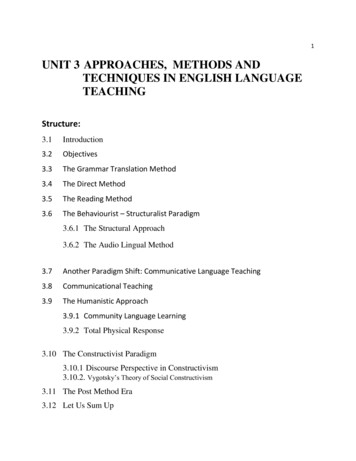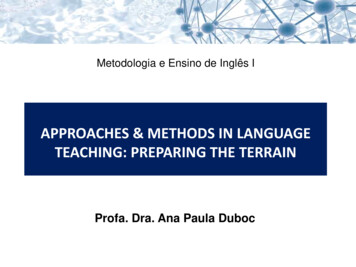
Transcription
Metodologia e Ensino de Inglês IAPPROACHES & METHODS IN LANGUAGETEACHING: PREPARING THE TERRAINProfa. Dra. Ana Paula Duboc
Do you know what concept maps are?
Warm-up 1: concept maplanguage
The tree metaphor (Monte Mór,2009)CLASSROOM TECHNIQUESTEACHING METHODSCONCEPTS:LANGUAGE, KNOWLEDGE, PEDAGOGYWhere do Istand here?
StudyReference:The nature of approaches and methods in language teaching. In: Richards, J. ;Rodgers, T. Approaches and methods in language teaching. Cambridge: CUP,1999. Fifteenth printing [Original 1986]
Anthony’s terminology“The arrangement is hierarchical. The organizational key is that techniquescarry out a method which is consistent with an approach . . . An approach is a set of correlative assumptions dealing with the nature oflanguage teaching and learning. An approach is axiomatic. 1t describes thenature of the subject matter to be taught. . . Method is an overall plan for the orderly presentation of language material,no part of which contradicts, and all of which is based upon, the selectedapproach. An approach is axiomatic, a method is procedural. Within oneapproach, there can be many methods . . A technique is implementational - that which actually takes place in aclassroom. It is a particular trick, strategem, or contrivance used to accomplishan immediate objective. Techniques must be consistent with a method, andtherefore in harmony with an approach as well. (Anthony 1963, p. 63-7 apudRichards and Rodgers, 1999, p. 15)”
Richard and Rodgers’s terminology“We see approach and method treated at the level of design, that level inwhich objectives, syllabus, and content are determined, and in which theroles of teachers, learners, and instructional materials are specified. Theimplementation phase (the level of technique in Anthony's model) we referto by the slightly more comprehensive term procedure. Thus, a method istheoretically related to an approach, is organizationally determined by adesign, and is practically realized in procedure.” (ibid, p. 16)
Richard and Rodgers’s terminology“The first level, approach, defines those assumptions, beliefs, and theoriesabout the nature of language and the nature of language learning whichoperate as axiomatic constructs or reference points and provide atheoretical foundation for what language teachers ultimately do withlearners in classrooms. The second level in the system, design, specifies therelationship of theories of language and learning to both the form andfunction of instructional materials and activities in instructional settings.The third level, procedure, comprises the classroom techniques andpractices which are consequences of particular approaches and designs”.(Richards & Rodgers, 1986, p. 154 apud Kumaravadivelu, 2006, p. 86)METHOD an umbrella term referring to a broader relationship betweentheory and practice
In: Brown (2000)
Task 1In Richards and Rodgers’s framework, the design part comprises the following aspects: The objectives of a certain methodThe language content selected and organized (the syllabus)The types of activities usedThe role of the teacherThe role of studentsThe role of instructional materials (coursebooks and the like)By making use of your personal, academic, and professional knowledge, brainstormideas/provide examples for each of the aspects listed above.Examples: how many objectives can come up with when it comes to theteaching/learning English? How many classroom activities can you think of? Howmight teachers behave/teach/act? How about the students?
Rodgers (2001)
Task 21. Identify the theories of language presented in the text. How do theyconnect to your previous background knowledge (mainly academicones)?2. Identify the theories of learning presentend in the text. How do theyconnect to your previous background knowledge (mainly, academicones)?meaningmaking#1
History of language teaching: introductionAntes da Renascença: predomínio da língua falada; ensino naturalDa Renascença à Revolução Industrial: aumento do prestígio do latim e dogrego; desenvolvimento de idiomas vernáculos; fascínio com a era clássica ea necessidade de sistematização do ensino das línguas clássicas; surgimentodo método tradicional (Grammar-Translation Method): Objetivo: ler textos canônicos Conteúdo: gramática e vocabulário Atividades: memorização, repetição e tradução (“em vez de uma técnicade ensino nascia uma liturgia”, Chagas, 1979, p. 26) Papel do professor: detentor e transmissor de conhecimento Papel do aluno: reprodutor do conhecimento (aluno-balde, cf. Machado) Papel do LD: essencial, única fonte de saber
Grammar Translation MethodBrown (1997); Richards & Rodgers (2000) dominated Europe from 1840s to 1940spreviously referred as Classical Method“a method without a language and learning theory”major focus on Reading and Writinglittle or no attention to Listening and Speakingvocabulary selectionendless lists of words and unusual grammar rules to be memorizedemphasis on Accuracydeductive learning: first the language is presented, then it ispracticed.
When was this bookfirst published?1894
What is its underlyingtheory of language?Theory of learning?Attention to theteaching of moralprinciples anduniversalizing treatmentof the subjectPhonological content:structure-based
First half of the XX century:vocabulary lists; translation; verbconjugation; biased and prejudiced ideasimbued in sentences such as “Thatnegress has very good teeth” and“A European is generally more civilizedthan an African” to be translated toA gramática da língua inglêsa,Portuguese (Paiva, 2009)First edition 1880 (34th edition, 1940)
Transition Period mid / late 19th century: linguists raised new ways of teaching fornew social demands related to increasing opportunities forcommunication among Europeans. emphasis on oral proficiency became essential! At the very beginning, there was a boom of conversation or phrasebooks for private study. Later, the courses started to take intoaccount other aspects of the language learning process. Marcel (1793 – 1896): on the importance of meaning in learning; Prendergast (1806 – 1886): on the importance of consideringcontext and different discursive situations Gouin (1831- 1896): a language is associated to movements oractions in a contextualized way (which would then lead to a morerecent method called TPR) and others.
Gouin’s series.Situations / themes as ways of organizing and presenting languageIn: Richards & Rodgers (2000)
The Reform Movement Reformist ideas became visible all over Europe Linguistics was revitalized with emphasis on Phonetics (IPAfounded in 1886). Later on, Structural Linguistics would found thebases of many teaching methods. Concerns: The study of the spoken language Phonetic training to guarantee good pronunciation The use of conversation texts and dialogues to introduceconversational phrases and idioms. An inductive approach to the teaching of grammar. Teaching new meanings through establishing association withinthe target language rather than by the mother tongue.
The Reform MovementHenry Sweet’s The Practical Study of Languages (1899) andits four teaching principles:1. Careful selection of what is taught2. Imposing limits on what is to be taught3. Arranging what is to be taught in terms of the four skills oflistening, speaking, reading, an writing4. Grading materials from simple to complex
The Direct Method: an implication Naturalistic principles of of language learning Translation was forbidden: that explains the term “direct” Also known as Natural Method Procedures: demonstration an action No textbooks used in the very beginning of the learning stage In the 20’s: decline of Direct Methods due to high concern on thesystematization of foreign language teaching theories (Directmethods were taken as a bit amateur)
The Berlitz Method isone of the greatestexamples of a DirectMethod
Direct Methods: the Berlitz MethodGuidelines for teachers in Berlitz’s method:meaningmaking#2Can you think of anydrawbacks of DirectMethods regarless oftheir relevance?In: Richards & Rodgers (2000)
“These principles provided the theoretical foundations for aprincipled approach to language teaching, one based on a scientificapproach to the study of language and of language learning. Theyreflect the beginnings of the discipline of applied linguistics - thatbranch of language study concerned with the scientific study ofsecond and foreign language teaching and learning”. (Richards &Rogers, ibid, p. 8)
bases of many teaching methods. Concerns: The study of the spoken language Phonetic training to guarantee good pronunciation The use of conversation texts and dialogues to introduce conversational phrases and idioms. An inductive approach to the teaching of grammar. Teaching new meanings through establishing association within
